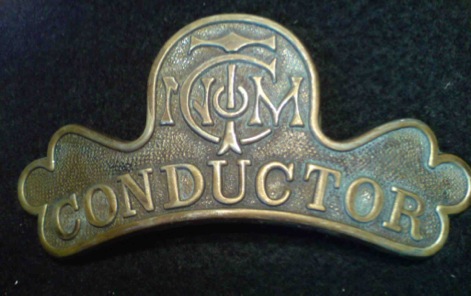North Metropolitan Tramways Company
Summary
In common with the vast majority of horse tramways in the UK, drivers simply wore informal but robust attire — trousers, jackets, waistcoats, shirts and ties, with overcoats and leather aprons also finding favour. Headgear appears to have largely followed the fashion of the day, initially the ubiquitous bowler hat, but in later years, increasingly the flat cap, straw boaters, and even panama-style hats; no badges of any description were worn on these hats.
Conductors were not issued with uniforms, but were expected to wear smart attire including a jacket, trousers, shirt and tie. The one item that the company did see fit to issue were squat kepi-style caps, which bore a large and somewhat unusually shaped cap badge (see below) comprising a monogram of the company initials ('NMTCo') above the grade 'CONDUCTOR'; brass and nickel examples have survived.
Drivers and conductors wore standard enamel Public Carriage Office licences (see link) whilst on duty; these were usually hung from a button or were attached to some other item such as a cash-bag strap.
The NMTCo certainly employed the services of inspectors and time keepers, though what uniforms they wore, if any, remains unknown.
For a history of the North Metropolitan Tramways Company, see: 'London County Council Tramways Volume 2, North London' by E R Oakley; The London Tramways History Group (1991).
Images
Horse tram drivers and conductors
A lovely studio portrait of a North Metropolitan Tramways conductor — although he has turned his head during the exposure, it nevertheless shows the smart yet informal nature of his attire (other than the cap), even down to the plain buttons on his overcoat. The kepi-style cap bears a prominent and unusually shaped badge comprising the wearer's grade and a monogram of the company's initials (see below). Photo courtesy of the LCC Tramways Trust Collection, with thanks to Dave Jones.
Conductor's cap badge — brass. With thanks to the National Tramway Museum.
Conductor's cap badge — nickel. Author's Collection.
An unidentified NMTCo horse car stands at Clapton Common, Hackney — photo purportedly taken in 1879. Photo courtesy of the Tramways and Light Railway Society, with thanks to David Voice.
A blow-up of the above photo showing three tramwaymen. All appear to be wearing informal attire, save for the kepi-style caps of the two individuals on the left (conductors?), which carry a large metal cap badge.
Conductor and driver with Horsecar No 217 on the Moorgate to Clapton route — photo undated, but possibly taken in the late 1880s or early 1890s. Photo courtesy of the Tramways and Light Railway Society, with particular thanks to David Voice.
The crew of Horsecar No 248, with additional conductor, stands at the Clapton Common terminus — photo undated, but given that the car is in unrebuilt condition, possibly taken in the 1880s. Photo courtesy of the Tramways and Light Railway Society, with thanks to David Voice
Conductor and driver pose for the cameraman with Horsecar No 102 on an Edmonton and Finsbury Park service — photo undated, but probably taken in the 1890s. Whilst the conductor sports a kepi-style cap, the driver simply has a bowler hat. Both men are wearing PCO licences (see link). Photo courtesy of the Tramways and Light Railway Society, with thanks to David Voice
Conductor and driver with an unidentified Hackney to Aldersgate Street horsecar — photo undated, but probably taken around the turn of the century. The driver is wearing a full length leather apron and a flat cap. Photo courtesy of the Tramways and Light Railway Society, with thanks to David Voice
Conductor and driver with an unidentified Hackney to Aldersgate Street horsecar — photo undated, but probably around the turn of the century and without doubt in summertime given that the driver and nearly all the male passengers (not shown) are wearing straw boaters. Photo courtesy of the Tramways and Light Railway Society, with thanks to David Voice
Various staff pose with Horsecar No 477 (Stamford Hill and Moorgate line) — photo undated, but probably taken in the 1890s. Photo courtesy of the Tramways and Light Railway Society, with thanks to David Voice
Horsecar 208 on the Aldersgate Street and Clapton route, with the driver sporting a wide-brimmed Panama style hat — photo undated, but probably taken in the late 1890s. Photo courtesy of the Tramways and Light Railway Society, with thanks to David Voice
An excellent photo of the staff of a former London Street Tramways depot - Cressy Road — taken in 1898, one year after the North Metropolitan Tramways Company take-over. The conductors are all wearing NMTCo cap badges. Photo courtesy of the Tramways and Light Railway Society, with thanks to David Voice
Blow-up of the above photo showing a driver (foreground) as well as several conductors, all of whom are wearing the distinctively shaped NMTCo cap badge on their kepi-style caps.
The badge above is most certainly not an issue of the 'North Metropolitan Tramways Company', but of the 'North Metropolitan Electric Power Supply Company'. The latter company traded under the name 'NorthMet', and was part of the 'Underground Group', which eventually included three major London tramways amongst its transport empire. The distinctive style of lettering seen on this badge only made its appearance in 1908/9, well after the demise of the NMTCo. With thanks to Nick Thurlow.